A Study on the Meta Analysis Technique Viewing Systematic Reviews of a Broadcast Investigation on Pandemic Disease
Vivek Kumar Chauhan1, Vikas Tyagi1, Vivek Tyagi2 and Pradeep Chaudhary3
1Department of Statistics, Meerut College Meerut-250004, India
2Department of Statistics, NAS College Meerut-250004, India
3Department of Statistics, CCS University Meerut-250004 India
Submission: April 13, 2023; Published: May 02, 2023
*Corresponding author: Vivek Kumar Chauhan, Department of Statistics, Meerut College Meerut-250004, India Biostat Biom
How to cite this article: Vivek Kumar Chauhan1, Vikas Tyagi, Vivek Tyagi and Pradeep Chaudhary. A Study on the Meta Analysis Technique Viewing Systematic Reviews of a Broadcast Investigation on Pandemic Disease. Biostat Biom Open Access J. 2023; 11(2): 555807. DOI: 10.19080/BBOAJ.2023.11.555807
Abstract
Meta analysis is used to collaborate results across the investigation to determine the overall consequence of the study. Meta analysis is concentrated on pragmatic issues of applied research phenomena creation of the research area. The paper deals prospective determination that may be concentrated in systematic reviews and meta-analyses used in social science research and life science research. The main issue are opportunity and destination of research. And identify the various sources of heterogeneity with different confounded moderators. Queries suitable for meta-analysis. Google/ Google scholar was used to access the evidences of government report. The paper presents a critique of the prospective decisions and forces in meta-analysis in medical research. The principal intention of this paper is to afford the improve methodology in systematic reviews is to improve the trans-disciplinary communication and ensures the encourage of the meta-analysis is different point of view. The research provides the more research looking at the stage of infection fatality rate is urgently needed to making the policy on the future.
Keywords: Meta-Analysis; Mortality Rate; Systematic Review; Disappeared Data
Introduction
A systematic review provides solution for the overall effect of the study. Meta analysis provides the recommendations that have been made on how to demonstrate them, the issue of publication or minor-study bias has been conscientiously forward [1]. It is strenuous for even accomplished meta-analyst to follow in progress methodological and scientific arguments and continue with latest discovery, especially across distinct considerable disciplines [2]. The year 2020 saw the exhibition of pandemic SARS-CoV-2 virus, which launch into Wuhan city in China and enlargement all over the world. One of the most searching questions to acknowledge during the COVID-19 pandemic has been regarding the true infection of the mortality rate of the disease. While case fatality rate is exceedingly responsible from abundant advertised data authority [3]. Case fatality rate existence the number of deaths divided by the number of confirmed cases it is a long way further strenuous to extrapolate to the measurement of all infected particular have died due to the infection because those who have very lenient, a representative or asymptotic illness are frequently left and unexposed and therefore excite from fatality rate computation [4]. There is a numerous approach to emphasize the mortality in a population. Retrospective study of the disease influenza has forecast the true number of cases and deaths from influenza like illness documentation and excess mortality estimates [5]. These may not be precise definition that CFR may both overestimate and equally underestimate the true number of illness due to disease in population [6]. The standard test for COVID-19 involve testing of nasopharyngeal swabs from patients suspected of having shrink the virus these arise some false negative [7] with one study demonstrating almost a district of patient’s incident a positive result following up to two previous false negatives [8]. The sensitivity of PCR is believed to be around 70% which may lead to the Aunder diagnosis of Covid-19 [9]. In Covid-19 exposure is a pandemic disease. There are conducted by many surveys, but many cases are not reported in the US, Europe and potentially worldwide [10-12].
Various Published Systematic Review on Pandemic Disease Covid-19
In [13] exertion in a Belgium and taken two time period and take a 7307 sample from position around sample and then the aggregate there are taken the units 193 and the total units 3397 samples take positive and combined effect the overall effect of mortality 1.1%. In [4] exertion in a Northern Italy taken 10 municipalities in Lombardy use the 5 year death data and accumulate the details from Italian Institute of Statistics. The total population incorporated municipalities was 50563. In this phenomenon the Bayesian model is used to evaluation mortality rate. And the conclusion of the month of February and April 1.29% increase to 4.25%. In [14] and the study New York state USA and the study for 9 days. In this investigation we use the cross-sectional studies. And used igg immunoassay approved for covid 19. And found out the result 12.5% specimen were reactive Cumulative Incidence was found to be higher in people. In [15] and studied Diamond Princess Cruise Ship worked in the period for 14-17 days. In this investigation a total of 3711 passenger and staff were tested whilst in quarantine. Utilize the data from world health organization situational reports. In [16] deliberate in Italy and worked from 32 days and accumulate data from Italy’s civil protection agency from each of Italy’s 20 regions. And final result estimated an infection fatality rate of 1.1% and case fatality rate of 12.7%. In [17] studied in ran and study for 1 month. In this investigation cluster randomized sampling utilized to obtain 551 rapid antibody tests for covid-19. And final outcome of this study finds 22% antibody seropositivity and 18% were asymptotic. There are arise many issues are described as following manner are given below
Issue 1: Opportunity and destination of review
Meta-analysis having been elucidate as a “gold standard” for evidence-based implementation in medicine. Deciding whether confirmation is suitable for meta-analysis is, at present, an interrogation of judgement and what is suitable evidence in one discipline may be unacceptable in another [18,19]. for inquiry which meta-analysis is not suited may be better addressed using a traditional narrative review, such as best-evidence synthesis, interpretive synthesis [20] or scoping reviews [21].
Issue 2: Taking the hypothesis for primary studies in reference to study designs
Social research used the systematic reviews and for emphasizing the use of the non-randomized designs. In social sciences trials with a indicative population may be considered more favorable than laboratory studies because of their ecological validity [22]. It is a random allocation to contemplation condition in social science experiments. The medical literature generally combines the laboratory trials, randomized designs and non-randomized designs [1,23]. And various sampling technique use such as non-random sampling and lack of treatment integrity introduce alternate explanations for treatment effect used in randomized trials [22,24,25]. Some authors work in a validity of research question [26]. Social researchers have developed detailed method for the purpose of concern in systematic review [27].
Issue 3: Suitability for effect of result
Systematic review furnishes the solution of contrasting measure use in every field like political science use popular authority used a very specific deterministic approach. As illustration most questions arise in the consideration of proceeding review of [28]. Some authors provide a reported solution used as a Statistics tool for different items while the other authors worked in a Statistical tool as jointly scale [29].
Issue 4: Finding the reporting in the reference of primary studies
The various journals use the unpublished thesis and use the distinct report for the evaluation purpose. Many statistical studies provide the solution of center of attention in the terms of the level of significance while in further studies we used the descriptive statistics to emphasize the report of the results. The various author pioneer work in the field of meta-analysis used in the systematic review of published research data [30]. The various reporting exists the solution for the randomized controlled trials.
Issue 5: Antecedent of heterogeneity
The fundamental research question arises in social science research as well life science research how the impact of an individual treatment for instance if we have a university-based study in the reference of drug prevention program different for colleges in reference to the income such as high-income region and low-income region. In this situation Meta- analysis provides a solution to examine the response of these questions by contrast of treatment of results across a different source of study. The various authors recognition the problems in many disciplines embrace the social sciences like [31], epidemiology [32] and ecology. In meta-analysis a very deliberate issue in reference to heterogeneity to determine the various effect size of the study. In meta- analysis we use the term standard regression, in this phenomenon we use the predictor variable and referred as “Confounded”. The term confounded is appropriate the following conversation specifically investigation-level characteristics that very scientifically use to some degrees are considered “confounded” [31]. In meta-analysis used the perception tool such as meta regression tools and prepared the meta- regression plot may be useful in attempting to estimate the confounding. In present phenomena the various complex and statistically opportunity options include network meta-analysis [33] Bayesian meta-analysis [34], and individual level data meta-analysis [35].
Methods
This investigation adopted an unadorned systematic assessment protocol. During the pandemic it has been an essential antecedent advice and accommodate many of the most recent estimates for epidemiological facts about the covid-19. The inclusion criteria for the studies were referencing the Covid-19 or the Sars-cov-2. Commenced an estimated population contagion destructiveness rate. Titles and abstracts were abandoned for acceptability and elimination if did not appropriate the inclusion criteria. If these messed the inclusion criteria, they were indicate the systematic review and meta -analysis. Estimates for contagion destructiveness rate and the confidence interval were concentrate for each study. All analysis and data conversion were execute in CMA. Sensitivity analysis were execute the stratum the results into description of study-serological vs non - by country and the month of calculation. In research to investigate the publication bias we use the funnel plot. An individual analysis was conducted using only survey results to investigate the stratification to determine the risk of bias.
Discussion
As pandemic covid-19 situation progresses it is very important to use the various indicator data sources when reporting the figures of the infection mortality rate. In general, some countries start the enhancing screening and surveillance and observe the increase in positive cases. That are the asymptotic and mild enough that they have so far avoided testing [36]. It has been concern that covid-19 is often spread from symptomatic cases. generally, up to 50% of all patients- and transmission may also be possible with covid-19 [37,38]. The main finding of the research is that there is very high heterogeneity. One reason that may the outcome of the government report with more prepared country suffering from the lower death rate those have efficient resources to combat a large outbreak. [39]. Some included studies [4,40] compared infection fatality rate (Table 1 & 2).
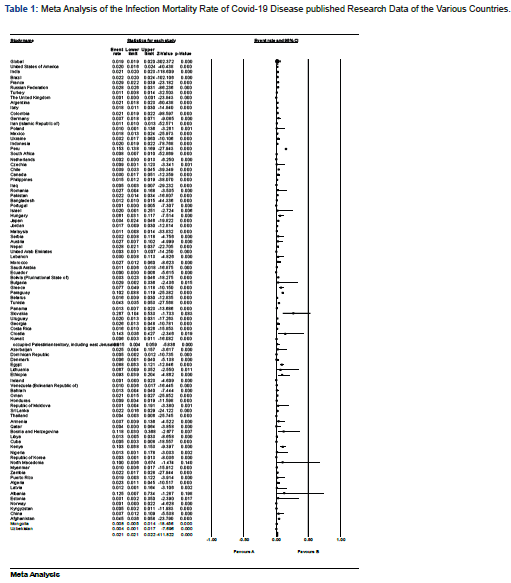

In this study we have the 92 study and find out the tau squared value is 96.719 and the standard error 0.189 and the p value is 0.000 which is less than the value is 0.05 than we can say that the result is significant, and it is true for evidence-based medicine than the pooled estimate is performed by the comprehensive meta-analysis software tool. In the fixed model we the single value lie between the range classified as lower limit 0.021 and upper limit 0.022. and the random model we find out the confidence interval lies between the 0.017 and the 0.022. And then the perform the various study of the states and in the study is 36 and find the tau squared value is 99.898. and the confidence interval between the value for random model is 0.008 and 0.010 and the value for the fixed model are 0.012 and 0.012. and the p value is less than 0.05 than we can say that the result is true for effective medicine. And the results are true for evidence -based medicine. And we find out the standard error is 0.074. In this study we have find out the graph shows the starting variability increasing and then the variability decreasing (Table 3 & 4 & 5) (Figure 1 & 2).

Interpretation
In meta-analysis the effect size is about contrasting studies and then amalgamate all the studies into a separate exploration. We acquisition that Q is very broad it measures the larger deviation across countries. As I2 is major origin which informs that the expanse of heterogeneity, hence for broad I2 give voice to distinguished than 25% then the meta-analysis should not explode the integrate combined effect size as meaningful. In this investigation we make the hypothesis that in selected countries the incorporate effect is not significant. We find the z value is -411,822 and the value of p is <0.00. Now we contrast the value of 95% CI or 0.05 level of significance. The result value is less than 0.05. So, we can say that combined effect is significant, now it is referred to as derived pooled estimate as an approach to true effect size. Tau (T) is a beneficial to extent the dispersion. The 95% prediction interval gives the range in which the point estimate of 95% of future studies will fall under the assumption that the true effect size is normally distributed [41].
Conclusion
The paper has epitomize enlightenment of an extensive assortment the origin of sources on how to trade in with four issues that may be come up against in systematic reviews and meta-analysis of appeal in social science research. A numerous literature provided from statistics, ecology, psychology, epidemiology has assemble a set of expedients for demonstration of researchers who may be focused these issues on the process of covenant their own systematic review and meta-analysis. Various disciplines include the members of advisory group ensure that the address of reviewers. The advisory group proposes every phase of research, specifically the review question help in methodological methods and the decision making. Experienced reviewers demonstrate the one or more issues that provide the solution of unpredictable with the current method. This paper provides the intentional as expedient research of the covid-19 disease.
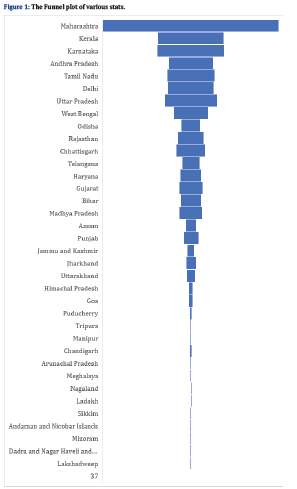
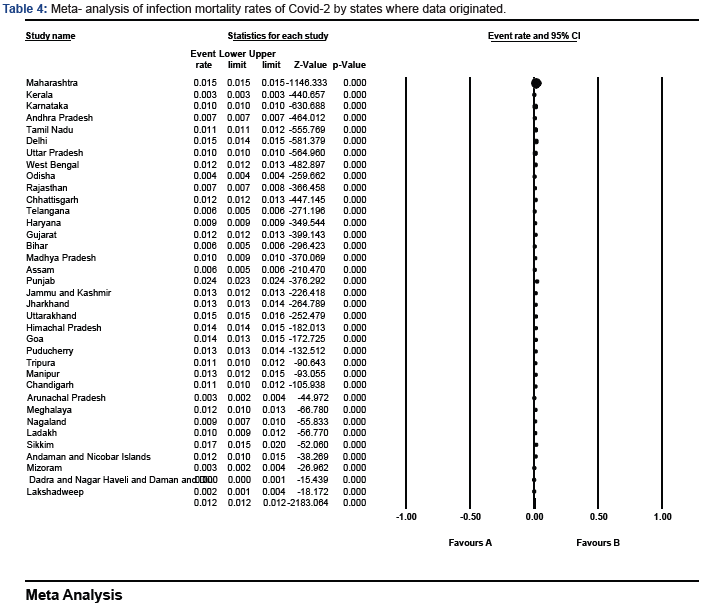
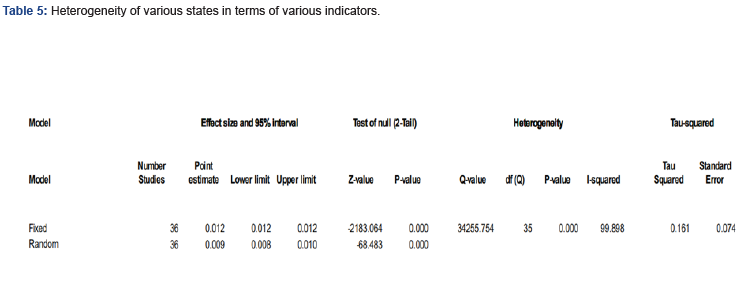
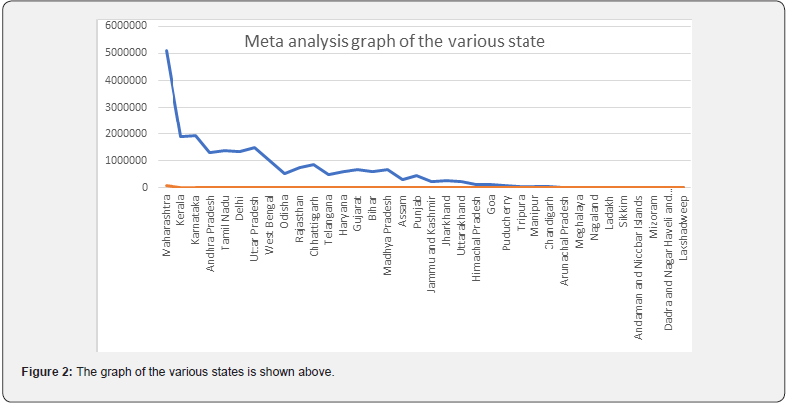
References
- Higgins JP (2011) Cochrane handbook for systematic reviews of interventions. Version 5.1.0, The Cochrane Collaboration.
- Schulze R (2007) Current methods for meta-analysis: Approaches, issues, and developments. Journal of Psychology, 215(2): 90-103.
- Kahathuduwa CN, Dhanasekara CS, Chin SH (2020) Case fatality rate in COVID-19: a systematic review and meta-analysis.
- Rinaldi G, Paradisi M (2020) An empirical estimate of the infection fatality rate of COVID-19 from the first Italian outbreak.
- Wong JY, Wu P, Nishiura H, Goldstein E, Lau EH et al. (2013) Infection fatality risk of the pandemic A (H1N1) 2009 virus in Hong Kong. American journal of epidemiology 177(8): 834-840.
- Spychalski P, Błażyńska Spychalska A, Kobiela J (2020) Estimating case fatality rates of COVID-19. The Lancet Infectious Diseases 20(7): 774-775.
- Anon Weekly Report of the population Serology Survey of the Corona Epidemic. Finland: Finnish government: (2020).
- Xiao AT, Tong YX, Zhang S (2020) False‐negative of RT‐PCR and prolonged nucleic acid conversion in COVID‐19: rather than recurrence. Journal of medical virology 92(10): 1755-1756.
- Fernández Barat L, López Aladid R, Torres A (2020) The value of serology testing to manage SARS-CoV-2 infections. European Respiratory Journal 56(2).
- Bendavid E, Mulaney B, Sood N, Shah S, Bromley Dulfano R (2021) Covid-19 antibody seroprevalence in santa clara county, california. International journal of epidemiology 50(2): 410-419.
- Erikstrup C, Hother CE, Pedersen OBV, Mølbak K, Skov et al. (2021) Estimation of SARS-CoV-2 infection fatality rate by real-time antibody screening of blood donors. Clinical Infectious Diseases 72(2): 249-253.
- Simon P (2020) Robust estimation of infection fatality rates during the early phase of a pandemic.
- Herzog S, De Bie J, Abrams S, Wouters I, Ekinci E et al. (2021) Seroprevalence of IgG antibodies against SARS coronavirus 2 in Belgium–a serial prospective cross-sectional nationwide study of residual samples (March–October 2020). Eurosurveillance 27(9).
- Rosenberg ES, Tesoriero JM, Rosenthal EM, Chung R, Barranco MA et al. (2020). Cumulative incidence and diagnosis of SARS-CoV-2 infection in New York. Annals of epidemiology, 48: 23-29.
- Russell TW, Hellewell J, Jarvis CI, Van Zandvoort K, Abbott S et al. (2020) Estimating the infection and case fatality ratio for coronavirus disease (COVID-19) using age-adjusted data from the outbreak on the Diamond Princess cruise ship, February 2020. Eurosurveillance 25(12).
- Villa M, Myers JF, Turkheimer F (2020) COVID-19: Recovering estimates of the infected fatality rate during an ongoing pandemic through partial data.
- Shakiba M, Nazari SSH, Mehrabian F, Rezvani SM, Ghasempour Z (2020) Seroprevalence of COVID-19 virus infection in Guilan province, Iran.
- Koricheva J (2013) Handbook of meta-analysis in ecology and evolution. In: Koricheva J, Gurevitch J, Mengersen K (eds.), Princeton University Press, USA.
- Ioannidis JP, Patsopoulos NA, Rothstein HR (2008) Reasons or excuses for avoiding meta-analysis in forest plots. Research methodology 336(7658): 1413-1415.
- Dixon Woods M, Cavers D, Agarwal S, Annandale E, Arthur A et al. (2006). Conducting a critical interpretive synthesis of the literature on access to healthcare by vulnerable groups. BMC medical research methodology 6(1): 1-13.
- Arksey H, Malley OL (2005) Scoping studies: towards a methodological framework. International journal of social research methodology 8(1): 19-32.
- Sampson RJ (2010) Gold standard myths: Observations on the experimental turn in quantitative criminology. Journal of quantitative criminology 26(4): 489-500.
- Shadish W, Myers D (2004) Research design policy brief. Oslo: Campbell Collaboration.
- Littell JH (2005) Lessons from a systematic review of effects of multisystemic therapy. Children and youth services review 27(4): 445-463.
- Shadish WR, Cook TD, Campbell DT (2002) Experimental and quasi-experimental designs for generalized causal inference. Houghton, Mifflin and Company, Boston, USA.
- Littell JH, Corcoran J, Pillai V (2008) Systematic reviews and meta-analysis. Oxford University Press, UK.
- Harden A, Thomas J (2005) Methodological issues in combining diverse study types in systematic reviews. International Journal of Social Research Methodology 8(3): 257-271.
- Mazerolle L, Higginson A, Eggins E (2013) Third party policing for reducing crime and disorder: A systematic review. Campbell systematic reviews 12(1): 1-77.
- Ren L, Cao L, Lovrich N, Gaffney M (2005) Linking confidence in the police with the performance of the police: Community policing can make a difference. Journal of criminal justice 33(1): 55-66.
- Lipsey M, Petrie C, Weisburd D, Gottfredson D (2006) Improving evaluation of anti-crime programs: Summary of a National Research Council report. Journal of Experimental Criminology 2(3): 271-307.
- Lipsey MW (2003) Those confounded moderators in meta-analysis: Good, bad, and ugly. The Annals of the American Academy of Political and Social Science 587(1): 69-81.
- Boily MC, Baggaley RF, Wang L, Masse B, White RG et al. (2009) Heterosexual risk of HIV-1 infection per sexual act: systematic review and meta-analysis of observational studies. The Lancet infectious diseases 9(2): 118-129.
- Lumley T (2002) Network meta‐analysis for indirect treatment comparisons. Statistics in medicine 21(16): 2313-2324.
- Sutton AJ, Abrams KR (2001) Bayesian methods in meta-analysis and evidence synthesis. Statistical methods in medical research, 10(4): 277-303.
- Riley RD, Lambert PC, Abo Zaid G (2010) Meta-analysis of individual participant data: rationale, conduct, and reporting. Research Methods & Reporting pp.340.
- Sutton D, Fuchs K, Dalton M, Goffman D (2020) Universal screening for SARS-CoV-2 in women admitted for delivery. New England Journal of Medicine 382(22): 2163-2164.
- Nishiura H, Kobayashi T, Yang Y, Hayashi K, Miyama T et al. (2020) The rate of under ascertainment of novel coronavirus (2019-nCoV) infection: estimation using Japanese passenger’s data on evacuation flights. Journal of clinical medicine 9(2): pp.419.
- Bai Y, Yao L, Wei T, Tian F, Jin DY et al. (2020) Presumed asymptomatic carrier transmission of COVID-19. Jama 323(14): 1406-1407.
- Scally G, Jacobson B, Abbasi K (2020) The UK’s public health response to covid-19. Bmj pp. 369.
- Modi C, Böhm V, Ferraro S, Stein G, Seljak U (2020) Total COVID-19 mortality in Italy: Excess mortality and age dependence through time-series analysis.
- Our World in Data (2020) Coronavirus (COVID-19) testing: tests per confirmed case.






























